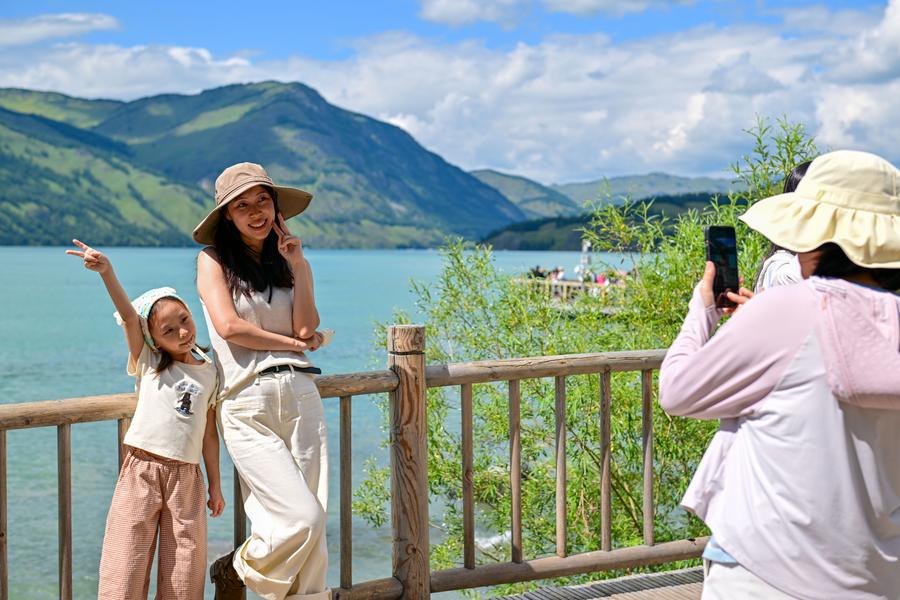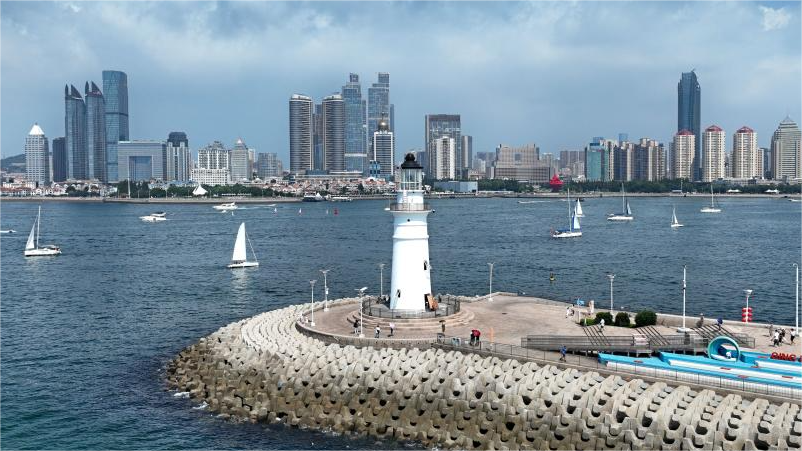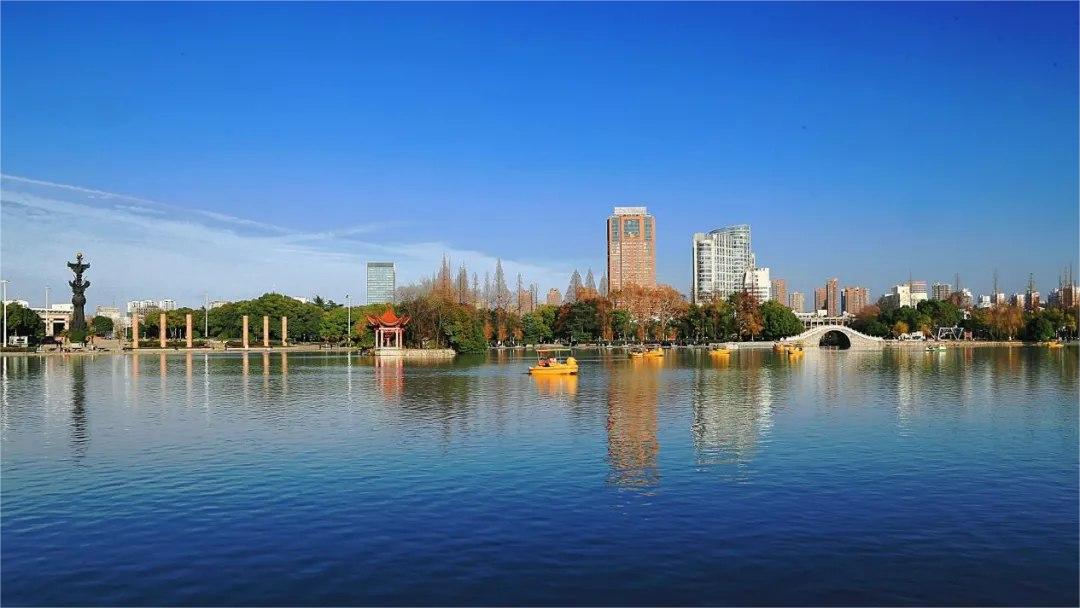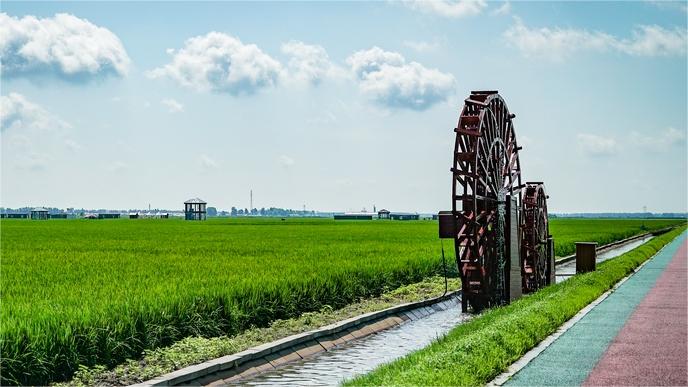Technology fuels China's sunscreen economy amid soaring summer heat

Tourists pose for photos in the Kanas scenic area of Altay, northwest China's Xinjiang Uygur Autonomous Region, July 22, 2024. (Xinhua/Ding Lei)
SHANGHAI, Aug. 20 (Xinhua) -- Armed with umbrella, hat, mask, sunglasses and ice sleeves, Wu Xiaoyan, a 38-year-old Shanghai resident, steps out on summer days fully shielded from the sun, and to such an extent that even acquaintances struggle to recognize her.
"Sunscreen products are becoming increasingly sophisticated, and I often buy and try some during online sales," Wu said.
Sun protection used to be simple and seemingly optional. However, with awareness of "photoaging" growing in recent years, sun protection has become an essential part of Chinese people's daily skincare routines.
Searching for terms like "sun protection" and "anti-photoaging" on social media platforms such as Xiaohongshu and Weibo, one can find millions of related notes and posts, sharing photoaging knowledge, skincare experiences, sunscreen product reviews and styling tips for sun-protective clothing.
Data from iResearch, an industry research and consulting institute, shows that the value of China's sunscreen clothing and accessories market had reached 74.2 billion yuan (about 10.4 billion U.S. dollars) in 2023, and is expected to increase to 95.8 billion yuan by 2026.
As China's sunscreen economy heats up along with the summer heat, the industry is undergoing a technological transformation. Companies are investing in science and technology to enhance both functions and user experience -- thereby meeting consumer needs in multiple ways.
China's national standards require ultraviolet (UV) protection products to meet two key criteria, namely an ultraviolet protection factor (UPF) greater than 40 and an ultraviolet light transmittance rate of less than five percent at wavelengths between 315 and 400 nanometers.
Many Chinese companies are delving into the development of very sophisticated sun protection products. Some embed molecules that reflect and absorb multiple wavelengths of light directly into yarn, rather than applying a UV-protective coating to the finished product. This approach ensures the material is not only sun-protective but also more breathable, comfortable and resistant to damage caused by washing.
There are also companies which incorporate materials that enhance the thermal conductivity of fibers during the spinning process, boosting the fabric's ability to conduct heat away from the body. When the skin touches such clothing, the fabric quickly transfers heat, creating a cooling sensation.
Sports brands have also entered the sunscreen market, leveraging their expertise in outdoor and sportswear to launch new products. Even traditional apparel companies are making new attempts at activity within this market. Bosideng, for instance, known for its down jackets, has ventured into the summer market.
"The number of Bosideng stores selling sun-protective clothing in 2024 has grown from the 2023 figure of 1,100 to about 1,500, reflecting rapid expansion," said Shen Yun, a planning expert with Bosideng.
"Sales of our sun-protective apparel have surged from an initial trial in 2022, which generated 100 million yuan, to 500 million yuan in 2023, and surpassed the one-billion-yuan mark in 2024," Shen added.
Bosideng attributes China's booming sunscreen economy to technological innovation. The company has developed a new type of sun protection fiber that enhances UV protection while maintaining the fabric's lightness and breathability.
Additionally, Bosideng is collaborating with research institutions to explore the application of biotechnology in the manufacturing of sun-protective clothing, aiming for production processes that are more environmentally friendly, said Shen.
As the sunscreen market expands, it is also becoming more diverse. Sun protection products are no longer just for women. Online shopping platform Tmall's data shows that searches for men's sunscreen clothing increased by 127 percent year-on-year during the first wave of sales of the "618" shopping festival in 2024. Children's sunscreen consumption is also on the rise, with some products seeing turnover growth of over 70 percent year on year, according to data from the Jingdong Institute of Consumer and Industrial Development in May.
Meanwhile, as people's lives become more varied, so do sun protection scenarios. Companies have launched products tailored specifically for the likes of daily commuting, outdoor activities, beach vacations and camping.
Ding Ying, an associate professor at Renmin University, noted that the growth of the sunscreen clothing market reflects Chinese consumers' focus on healthy and environmentally friendly consumption.
Deng Zhidong, an expert in industrial economy and investment, recently said in a media interview that the future of the sunscreen market lies in diversification and intelligence, in alignment with consumers' quest for an enhanced quality of life.
Diversification means the market will offer a richer variety of products, catering to daily protection, outdoor sports, water activities and more, with customized options for different skin types and age groups, Deng explained.
The requirement of intelligence translates into sunscreen products integrating more technological innovations, likely featuring systems that automatically sense UV intensity and adjust protection accordingly, he added.
Photos
Related Stories
Copyright © 2024 People's Daily Online. All Rights Reserved.









